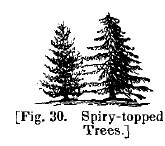Spiry-topped trees (Fig. 30) are distinguished by straight leading stems and horizontal branches, which are comparatively small, and taper gradually to a point. The foliage is generally evergreen, and in most trees of this class hangs in parallel or drooping tufts from the branches. The various evergreen trees, composing the spruce and fir families, most of the pines, the cedar, and among deciduous trees, the larch, belong to this division. Their hue is generally much darker than that of deciduous trees, and there is a strong similarity, or almost sameness, in the different kinds of trees which may properly be called spiry-topped. From their sameness of form and surface this class of trees, when planted in large tracts or masses, gives much less pleasure than round-headed trees; and the eye is soon wearied with the monotony of appearance presented by long rows, groups, or masses, of the same form, outline, and appearance; to say nothing of the effect of the uniform dark color, unrelieved by the warmer tints of deciduous trees. Any one can bear testimony to this, who has travelled through a pine, hemlock, or fir forest, where he could not fail to be struck with its gloom, tediousness, and monotony, especially when contrasted with the variety and beauty in a natural wood of deciduous, round-headed trees.

